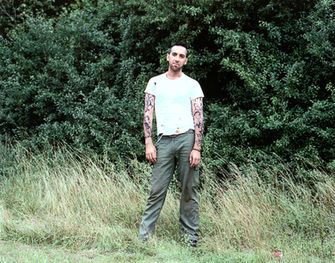

The West Country is a part of England that evokes ancient memories. It is the sacred land of Stonehenge, crop circles, ley-lines and bygone burial sites. With an unseen personality it shapes the lives of those who stay. It is the picture book home to farmers and villagers that go back generations and who still tread some of the oldest tracks in Europe. Along these ancient roads have come strangers, itinerants and Gypsies. People who are mistreated by society because of their beliefs and what is valued in their way of life. A way of life where people come before property and financial value, and where others are judged by what they are rather than what they look like or have.
a tale of fate and human capacity for endurance in an uncaring world


And then there are the Travelers of the New Age. Those who have chosen to flee the decay of the big cities, hiding themselves away in woods and farmland on the outskirts of an antagonistic society.


A Place To Stay is a story of love between a Traveler and a Gypsy woman. Set in a magical landscape that is all too quickly slipping away, it is about the grandest and most humble aspects of a human life.

It is about fate, and how people manage to endure their lives in an uncaring world by creating ideals by which to live and dreams to live for.

A Place To Stay captures the evocative beauty of English countryside.
Set against this backdrop, a traveler and a Gypsy woman are thrown together by society's rejection of their customs and ways. In this place, a love develops that hides its own mystery - the magic of the Wiltshire crop circles, and the need for a deeper understanding of nature and destruction. A tragedy that has profound consequences on both lives.

Director Marcus Thompson, has gone to great lengths to consult experts in this field and to include the spiritual and environmental impact that is so strongly felt by those who visit and research the mystery.
The story conveys powerful messages that have a real and urgent place in our world.

ADDITIONAL VIDEOS

TREES
‘The Battle Of Newbury’ as it came to be known, took place in the late nineties when the destruction of around 10,000 trees was perpetrated in Berkshire for the construction of the Newbury bye-pass. It led to the arrests of over 800 protesters who bravely fought in vain to save the further devastation of our shrinking natural environment, I cut this short film as an homage to those valiant men and women and their heroic stand, as part of my research for ‘A Place To Stay’.
TIMELAPSE
I have to say that the most lasting memory I have of shooting ‘A Place To Stay’ was the night I spent filming in a field with my Director Of Photography, Mirko Beutler. It was a time-lapse sequence of the cosmos as it glided past above us in the darkness. The location was a wheat field under the White Horse near Alton Barnes, Wiltshire. It was pure magic, and the footage looks wonderful. He is a brilliant DOP. As the 35mm camera clicked away through the night we witnessed a group of about 10 guys dressed totally in black and wearing balaclavas making their way silently through the fields, unaware that we were watching them. Crop circles were appearing a lot in Wiltshire that summer. How the one in this clip appeared remains a mystery, but what a beauty.

STOWE - ON - THE - WOLD
A short film made during research for ‘A Place To Stay’
Stowe-on-the-Wold,
Where the wind blows cold.
Where horses young and old are sold,
Where farmers come to spend their gold.
Where men are fools and women are bold
and many a wicked tale is told.
High on the freezing Cotswold.
The pubs and shops close and the cops appear in force when thousands of Gypsies descend on the ‘quaint’ town of Stowe twice a year. Fairs have been held in the market square by Royal Charter since 1330 and in May and October a horse fair is still held in muddy fields near the town. Thousands of Gypsies and Travellers come from all over the country to buy and sell horses and generally have a good time, sharing their traditional values. I shot this short film as part of the research for ‘A Place To Stay’.
PRODUCTION IMAGES


Interview with the Director
CCC:
Where did 'A Place To Stay ' originally come from?
MT:
I was over half way through the screen adaptation of Hardy’s ‘Jude The Obscure’, when the BBC announced they were going to produce a made for TV version. I’d walked every mile of every page of the novel, and I fell in love with the Ridgeway. It’s one of the oldest tracks in Europe and runs west across southern England. The views are stunning - really beautiful, a luxury of landscape. Hardy only wrote about real places, you can really live his novels.
CCC:
So what happened to ‘Jude The Obscure’?
MT:
I had to dump it and move on. But by then my heart was set on making an epic love story. Hardy-esque, with little people in vast landscapes. Like the paintings of John Constable and David Lean’s movies. Constable was a story-painter. Story telling - It’s what the English are very good at. Look at Shakespeare and Dickens.
CCC:
Has David Lean influenced you?
MT:
Absolutely. He was the master story-teller. I think it has a lot to do with his background as an editor. Creating the illusion of events unfolding in logical sequence... I think that’s Karel Reisz.



CCC:
Editing is also your background - does it help you direct?
MT:
It definitely helps, but being obsessed with film making for its own sake can get in the way. Until recently I considered how a story was told more important than the story itself. I think that was a mistake, and led to self indulgence on my part. I concentrated too much on the film making - camera angles, editing, sound effects, music etc., and not enough on the actors and the telling of the story. With this film, for the first time, I set out simply to tell the audience the story - no gimmicks, no flashy effects or camera angles - just the story. The way it’s told is still important, but it’s told in a completely functional way.
CCC:
So how did you tackle the film making in 'A Place To Stay' ?
MT:
Like a painter - a story painter - like Reubens or Titian. All landscape painting goes back to Titian. So the canvas I chose was wide. I couldn’t afford it, but I had to shoot in cinemaScope, there wasn’t an alternative. Just as A4 is so suitable for a page of type - so ‘scope is for landscape photography. The landscapes in this film have personalities of their own - they become characters, not just a background of scenery in a figure painting. And they change mood - there are no two more different landscapes than the same under altered skies, so we spent hours looking up at the movement of clouds across the sky. It’s like Constable said, ‘no two days are alike, nor even two hours’. We shot beautiful landscapes under magnificent cloud formations.



CCC:
So what is the story-line in 'A Place To Stay'?
MT:
I wanted to tell the story of star-crossed lovers. Actually, it goes back further than that. When ‘Jude’ fell through, I wanted to replace it with something that had the same of sense of place, and the same quota of tragedy. It all fell into place, once I had chosen the location for the story. I went further west along the Ridgeway, across to Wiltshire - the magical land of white horses and ancient burial sites.
CCC:
And crop circles.
MT:
That’s right. When ‘Jude’ fell through Peter King said - why don’t you make a film about crop circles? It was a subject that I knew nothing about, so I got a load of books out of the library. At the time, Colin Andrews and Busty and Terrence Meadon were the only people in print. For me, Colin was, and still is the leading authority on the subject - that’s why I asked him to be a consultant on the movie. He also loves the landscape at Alton Barnes and knows it like the back of his hand.

CCC:
So how did the landscape help with the story?
MT:
Well, it was very straight forward. I asked myself - who lives there? Farmers, Villagers, Gypsies and Travelers, and city-slickers at weekends. Basically, they all hate each other. There’s a lack of trust and respect and understanding. That’s why I wrote Jessie’s lines “People think we’re dirty - ‘least I don’t shit in my own ‘ome.” I got to know some Gypsies. I shouldn’t think the Queen serves tea from cleaner or finer porcelain than I was offered by Gypsies I talked to. Anyway, once I established who lived there, the story came quite quickly. I chose to tell it through the eyes of a local beat Bobby.
CCC:
Why?
MT:
Going back to Dickens, he said that a story-teller and a story-reader should establish a mutual understanding as soon as possible, and that’s what I tried to do from the start by using the Bobby. I established early on that this man was honest, caring and broad-minded, with the welfare of the community as a whole as his main preoccupation. The audience can trust this guy, and in that way I get their trust, since I’m telling the story through him. The twist, of course, is that he’s so old that his mind is on the blink, so I get a lot of artistic license as well.



CCC:
Do you mean with crop circles?
MT:
I mean with everything that the movie touches on, and that’s a lot. Crop circles, religion, tea leaf reading, science fiction, the environment, the police, social services, central heating, the great outdoors... and death... and life after death.
CCC:
Do you believe in these things?
MT:
The film’s not about what I believe - it’s about what I see. Crop circles exist, churches exist, some people feel closer to their God in a crop circle - either way - we’re not alone. Tea leaf reading exists - in our film, as it happens, every word of a tea leaf reading comes to pass - for both the reader and inquirer.
CCC:
And the Afterlife?
MT:
We’re all on a never ending journey, all part of the whole. It’s just like the Bobby says in the film: ‘it’s a big adventure’.

A Place To Stay Reviews
'The British film industry and Marcus Thompson have something to be proud of here. The movie has clearly been made with sincere passion and should fill the theatres with intrigue and sadness as the story conveys powerful messages that have a real and urgent place in our troubled world.'
Colin Andrews
'I went to the advance screening of "A Place to Stay" in London ten days ago. Marcus is a man who has done his utmost to put together a motion picture, at significant personal expense and time, which tells a good story involving the crop circles without sensationalism. And WITHOUT getting hooked into the shallow debate about where they come from. He simply and beautifully conveys the wonder and magic, and the EXPERIENCE of being inside these temples of grain.'
Peter Sorensen
















